First Impressions
Well, much to your disappointment I'm sure, I don't have any stories or pictures of kangaroos hopping around the streets of Melbourne. But Bruce has a 4 x 4 that he uses for outback adventures, so just wait! Nonetheless, here are some of the more mundane sights and sounds of Melbourne.
WINTER IN MELBOURNE
It is winter here. To me, it's a lot like Boston in November. Cloudy, grey, chilly, rather windy, and rainy at times. The days are short, getting light at around 7AM and dark at 6PM. The high is in the mid-50s, which I found shockingly cold after a month in the Texas summer heat. (I have to say, though, it's amazing to me that as many years as I have spent in the Northeast, I manage to forget every year when the temperature falls that 50 degrees, or even 59 degrees, is actually cold. I have been cold quite often because I simply did not wear a heavy enough jacket.) Most of the dead autumn leaves have fallen off the trees here. Interestingly, in Australia some trees don't lose their leaves; instead, they shed their bark. And some trees lose both. I read that this happens in Australia, and it is true. What a strange sight that is. It is strangely beautiful.

Despite the cold, people still eat outside. Melbourne has a lot (or "heaps", as they say here) of cafes with outdoor seating, and the key to enjoying it in winter is the outdoor heating. The cafes have these great heating lamps above the tables, under which I've huddled while walking more than once.
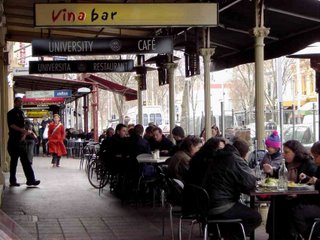
Gail tells me that the weather will get better soon. I guess it's fitting though to be cold and grey since that's how my academic year has begun for so many years in Boston and New York. Only I have spring to look forward to in just a short while instead of a seemingly endless winter.
THE MOST LIVEABLE CITY
Melbourne reminds me of Boston in many other ways, as well, but somehow this city has earned the title of "Most Liveable City", while I don't think Boston ever will; maybe it's the temperate climate. (Melbourne actually recently lost its top ranking to Vancouver.) All in all, Melbourne is a very accomodating city. It is very walkable and has good public tranportation. It doesn't have subways, but it has trams (above-ground, electrical), buses, and trains. It's also a great place for bikes, which I think I'll be getting soon. There are a lot of parks, gardens, and museums, too, but I've only managed to see them in passing. Its downtown reminds me a lot of Boston's Downtown Crossing, with streets that are only for pedestrians and trams and lined with shops and department stores. Architecturally, it has a mix of modern and older styles, and it's a nice city to look at over all. I haven't seen any really rundown areas yet. Around Melbourne Uni, the suburb of Carlton is like other college towns, kind of like Harvard Square, with lots of resturants, stores, and designer boutiques.
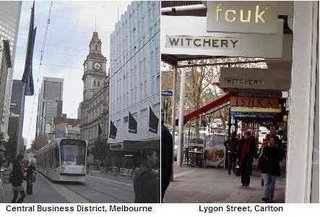 Ethnically Melbourne is very diverse. I don't know what the percentages are, but there are heaps of Asians here. It makes me feel like I'm back at Columbia, actually. This is probably moreso around the school, since Melbourne Uni attracts more international students than any other school (I think), many of whom come from China, Taiwan, and Indonesia. Carlton actually has a large Greek and Italian population, with the largest Greek population outside of Greece, even larger than some cities in Greece. It seems like 70% of the restaurants and cafes in Carlton are Italian, and for the World Cup final, they shut down several blocks of its main street from 10PM to 3AM. I didn't go out to watch, but the Italian flags draped around people's shoulders and waving out of cars, and the shouts of I-TAL-IA gave me the distinct impression that Italy had won. People were still leaving the celebration at 11AM Monday morning.
Ethnically Melbourne is very diverse. I don't know what the percentages are, but there are heaps of Asians here. It makes me feel like I'm back at Columbia, actually. This is probably moreso around the school, since Melbourne Uni attracts more international students than any other school (I think), many of whom come from China, Taiwan, and Indonesia. Carlton actually has a large Greek and Italian population, with the largest Greek population outside of Greece, even larger than some cities in Greece. It seems like 70% of the restaurants and cafes in Carlton are Italian, and for the World Cup final, they shut down several blocks of its main street from 10PM to 3AM. I didn't go out to watch, but the Italian flags draped around people's shoulders and waving out of cars, and the shouts of I-TAL-IA gave me the distinct impression that Italy had won. People were still leaving the celebration at 11AM Monday morning. Given its ethnic diversity, Melbourne's restaurants are also ethnically diverse, which I'm thankful for. There are plenty of Vietnamese, Malaysian, Chinese, Japanese, Thai and Middle Eastern restaurants. I have managed to find two Korean restaurants, one pretty good and one not so great. I don't know if I've had "Australian" food yet, but I'll let you know when I have my first bite of kangaroo.
I'm still learning what makes Melbourne one of the most liveable cities in the world, but I think part of it is that it has something for everyone. Like New York, each of its neighborhoods has a distinct character, places that are somewhat like the East Village, SoHo, the Upper West Side and the people that make the neighborhoods what they are. And then there are its suburbs, which are like American suburbs with their plazas and malls, which there isn't much to say about.
WHERE AM I AGAIN?
Well, I've pretty much described Melbourne in terms of the U.S. cities I've lived in. So much for flying 21 hours to be in foreign country! Don't get me wrong--I am really enjoying this city, but, superficially, I can't say that I get the distinct feeling that I am somewhere different, other than the Australian accent I hear all around me and the colorful Australian money. (And contrary to the stereotype we so fondly hold, only one person has greeted me with "G'day" in my first two weeks; others have said, "hi"). Oh, and I did see a small Aborigine protest march; they were shouting "Always was, always will be, aboriginal land!". Overall, though, most of what I see is similar to what I see at home, and I guess that's because it's not different in some fundamental ways; it's an English-speaking, economically developed, Western country.
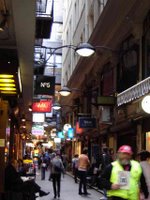 In Australia, there is a rivalry between Sydney and Melbourne that is simply a part of the culture. It is said that they are quite different, Sydney being more American in flavor, while Melbourne is more European. I've never spent much time in Europe, but I guess Melbourne does have a European aura. It has great little alley ways crammed with cafes, shops, and restaurant, and there are a lot of nooks and crannies that I'm looking forward to exploring.
In Australia, there is a rivalry between Sydney and Melbourne that is simply a part of the culture. It is said that they are quite different, Sydney being more American in flavor, while Melbourne is more European. I've never spent much time in Europe, but I guess Melbourne does have a European aura. It has great little alley ways crammed with cafes, shops, and restaurant, and there are a lot of nooks and crannies that I'm looking forward to exploring.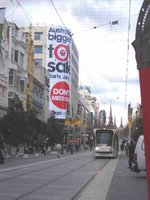 Yet, outside of those little alley ways, America’s fingerprints are all over the place. Melbourne is a city where 7-11, KFC, Subway, and Starbucks abound. (Why does a place like Melbourne, which is brimming over with cafes, no pun intended, even need Starbucks? How does Starbucks survive?). It also has several Borders, Nine West stores, Payless Shoes, Target and Big W, which is basically WalMart, (but Melburnians vehemently deny this, according to Ryan, despite, as he pointed out, the same color scheme and "every day low prices"). I admit I’m disappointed by all these American chain stores. Bruce informed me that Target, 7-11, Subway, and other fast-food chains are franchises that are Australian-owned (i.e., not planted here by the American parent companies), but still.
Yet, outside of those little alley ways, America’s fingerprints are all over the place. Melbourne is a city where 7-11, KFC, Subway, and Starbucks abound. (Why does a place like Melbourne, which is brimming over with cafes, no pun intended, even need Starbucks? How does Starbucks survive?). It also has several Borders, Nine West stores, Payless Shoes, Target and Big W, which is basically WalMart, (but Melburnians vehemently deny this, according to Ryan, despite, as he pointed out, the same color scheme and "every day low prices"). I admit I’m disappointed by all these American chain stores. Bruce informed me that Target, 7-11, Subway, and other fast-food chains are franchises that are Australian-owned (i.e., not planted here by the American parent companies), but still.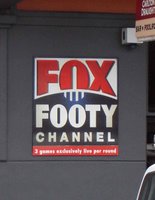 Its media is also very American. Hollywood blockbusters fill the theaters, which is no surprise, and its television programming is also filled with American shows. Yes, Dear. According to Jim. Home Improvement. Desperate Housewives. Boston Legal. Grey’s Anatomy. Days of Our Lives. The Young and the Restless. Judge Judy. Dr. Phil! And this is just on their basic TV stations. There must be 50 other American shows on what I gather to be their cable lineups. They have Fox, two Fox Sports channels, Nickelodeon, Comedy Central (with pretty much all American shows). Maybe I shouldn’t be surprised, since when I went to Guatemala, nearly all their TV programming was American, too (I was told that 70% of the TV media was American-owned down there), but I am.
Its media is also very American. Hollywood blockbusters fill the theaters, which is no surprise, and its television programming is also filled with American shows. Yes, Dear. According to Jim. Home Improvement. Desperate Housewives. Boston Legal. Grey’s Anatomy. Days of Our Lives. The Young and the Restless. Judge Judy. Dr. Phil! And this is just on their basic TV stations. There must be 50 other American shows on what I gather to be their cable lineups. They have Fox, two Fox Sports channels, Nickelodeon, Comedy Central (with pretty much all American shows). Maybe I shouldn’t be surprised, since when I went to Guatemala, nearly all their TV programming was American, too (I was told that 70% of the TV media was American-owned down there), but I am. Interestingly, the Americanization of this city came up in an article I read in last Sunday's edition of The Age, the Melbourne daily. It was called "My Kind of Melbourne", and prominent local figures were asked their thoughts on how to make this most liveable city even better. The article remarks, "We have the foundations to create a city truly deserving of the 'liveable' tag. To get there, we need foresight and daring—and, according to several of our respondents, we need to look more to European traditions and avoid the freeway and "Disney World" mall culture of America. ‘We could have followed the European path but we have chosen the US path for whatever reason. The more human path is the European path,’ says Melbourne artist Jon Cattapan…" According to the article, Melbourne, like other large cities is dealing with issues of urban sprawl and lack of affordable housing. People want improved, and even free, public transportation (wouldn't that be great!), fewer cars on the road, more pedestrians and bikes.
Again, I haven't spent much time in Europe, so I don't know exactly what the more human path is that the European traditions allow for, but I'd love to know.
I'm looking forward to meeting more Aussies because I'm sure the differences between our cultures is more subtle and more fundamental than what I've been able to see in my first two weeks.


0 Comments:
Post a Comment
<< Home